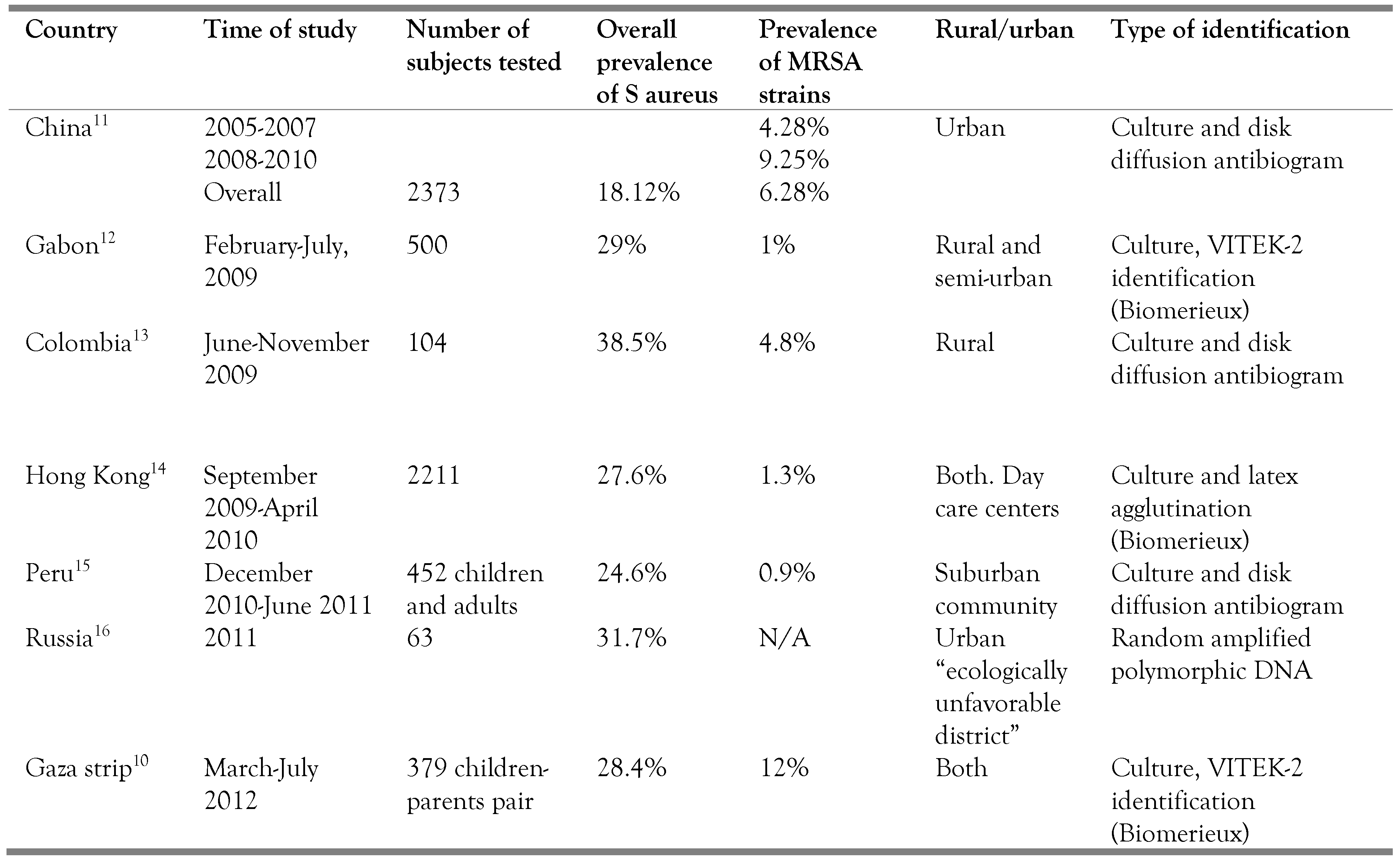Prevalence of Nasal Carriage of S aureus in Children
Abstract
 |
Acknowledgments
Conflicts of Interest
References
- Weidenmaier, C.; Goerke, C.; Wolz, C. Staphylococcus aureus determinants for nasal colonization. Trends Microbiol 2012, 20, 243–250. [Google Scholar] [CrossRef] [PubMed]
- Kuehnert, M.J.; Kruszon-Moran, D.; Hill, H.A.; et al. Prevalence of Staphylococcus aureus nasal colonization in the United States, 2001-2002. J Infect Dis 2006, 193, 172–179. [Google Scholar] [CrossRef] [PubMed]
- Graham PL3rd Lin, S.X.; Larson, E.L. A U.S. population- based survey of Staphylococcus aureus colonization. Ann Intern Med 2006, 144, 318–325. [Google Scholar] [CrossRef] [PubMed]
- Abudu, L.; Blair, I.; Fraise, A.; Cheng, K.K. Methicillin- resistant Staphylococcus aureus (MRSA): A community- based prevalence survey. Epidemiol Infect 2001, 126, 351–356. [Google Scholar] [CrossRef] [PubMed]
- Horner, C.; Parnell, P.; Hall, D.; Kearns, A.; Heritage, J.; Wilcox, M. Meticillin-resistant Staphylococcus aureus in elderly residents of care homes: Colonization rates and molecular epidemiology. J Hosp Infect 2013, 83, 212–218. [Google Scholar] [CrossRef] [PubMed]
- den Heijer, C.D.; van Bijnen, E.M.; Paget, W.J.; et al. Prevalence and resistance of commensal Staphylococcus aureus, including meticillin-resistant S aureus, in nine European countries: A cross-sectional study. Lancet Infect Dis 2013, 13, 409–415. [Google Scholar] [CrossRef] [PubMed]
- Fritz, S.A.; Hogan, P.G.; Hayek, G.; et al. Staphylococcus aureus colonization in children with community-associated Staphylococcus aureus skin infections and their household contacts. Arch Pediatr Adolesc Med 2012, 166, 551–557. [Google Scholar] [CrossRef] [PubMed]
- McKinnell, J.A.; Huang, S.S.; Eells, S.J.; Cui, E.; Miller, L.G. Quantifying the impact of extranasal testing of body sites for methicillin-resistant Staphylococcus aureus colonization at the time of hospital or intensive care unit admission. Infect Control Hosp Epidemiol 2013, 34, 161–170. [Google Scholar] [CrossRef] [PubMed]
- Streinu-Cercel, O. Expected sensitivity to antibiotics in bacterial infections. GERMS 2013, 3, 7. [Google Scholar] [CrossRef] [PubMed]
- Biber, A.; Abuelaish, I.; Rahav, G.; et al. A typical hospital- acquired methicillin-resistant Staphylococcus aureus clone is widespread in the community in the Gaza strip. PLoS ONE 2012, 7, e42864. [Google Scholar] [CrossRef] [PubMed]
- Deng, J.J.; Wan, C.M.; Mu, D.Z.; et al. Nasal carriage of community-acquired staphylococcus aureus and drug sensitivity tests in healthy children in Chengdu. Sichuan Da Xue Xue Bao Yi Xue Ban 2012, 43, 391–394. [Google Scholar] [PubMed]
- Ateba Ngoa, U.; Schaumburg, F.; Adegnika, A.A.; et al. Epidemiology and population structure of Staphylococcus aureus in various population groups from a rural and semi urban area in Gabon, Central Africa. Acta Trop 2012, 124, 42–47. [Google Scholar] [CrossRef] [PubMed]
- Rebollo-Perez, J.; Ordonez-Tapia, C.; Herazo-Herazo, C.; Reyes-Ramos, N. Nasal carriage of Panton Valentine leukocidin-positive methicillin-resistant Staphylococcus aureus in healthy preschool children. Rev Salud Publica (Bogota) 2011, 13, 824–832. [Google Scholar] [CrossRef] [PubMed]
- Ho, P.L.; Chiu, S.S.; Chan, M.Y.; et al. Molecular epidemiology and nasal carriage of Staphylococcus aureus and methicillin-resistant S. aureus among young children attending day care centers and kindergartens in Hong Kong. J Infect 2012, 64, 500–506. [Google Scholar] [CrossRef] [PubMed]
- Carmona, E.; Sandoval, S.; García, C. The frequency and antibiotic susceptibility of Staphylococcus aureus from nasal swabs in an suburban marginal population in Lima, Peru. Rev Peru Med Exp Salud Publica 2012, 29, 206–211. [Google Scholar] [CrossRef] [PubMed]
- Baksheeva, S.S.; Avetisian, L.P.; Chernukha, M.; Shaginian, I.A. Genetic diversity of Staphylococcus aureus strains that colonize nose mucous membrane of children living in a large industrial city. Zh Mikrobiol Epidemiol Immunobiol 2011, 52–54. [Google Scholar]
© GERMS 2013.
Share and Cite
Preoţescu, L.L.; Streinu-Cercel, O. Prevalence of Nasal Carriage of S aureus in Children. GERMS 2013, 3, 49-51. https://doi.org/10.11599/germs.2013.1035
Preoţescu LL, Streinu-Cercel O. Prevalence of Nasal Carriage of S aureus in Children. GERMS. 2013; 3(2):49-51. https://doi.org/10.11599/germs.2013.1035
Chicago/Turabian StylePreoţescu, Liliana Lucia, and Oana Streinu-Cercel. 2013. "Prevalence of Nasal Carriage of S aureus in Children" GERMS 3, no. 2: 49-51. https://doi.org/10.11599/germs.2013.1035
APA StylePreoţescu, L. L., & Streinu-Cercel, O. (2013). Prevalence of Nasal Carriage of S aureus in Children. GERMS, 3(2), 49-51. https://doi.org/10.11599/germs.2013.1035




